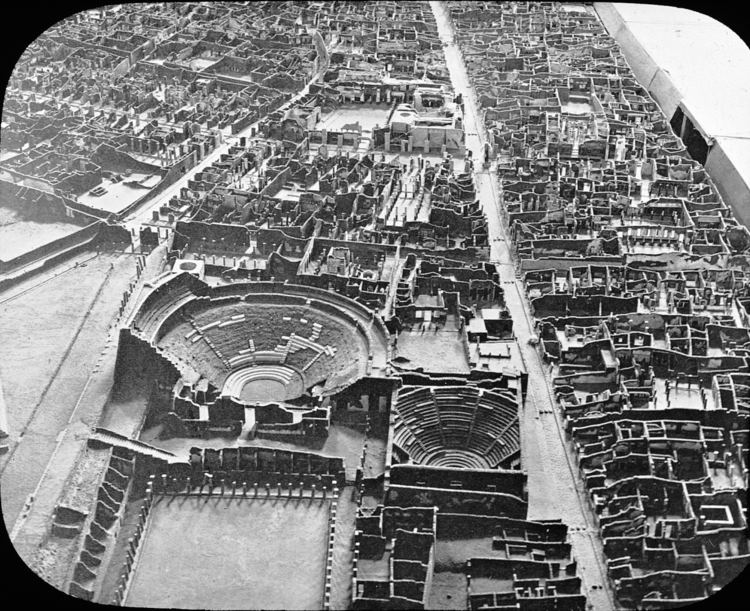 | ||
The theatre area of Pompeii is located in the southwest region of the city. There are three main buildings that make up this area: the Large Theatre, the Odeon (small theatre), and the Quadriporticum. This served as an entertainment and meeting center of the city. Pompeii had two stone theatres of its own nearly two decades before the first permanent stone theatre was erected in Rome in the 50s BCE.
Contents
The Large Theatre
The Large Theatre was built into a natural hill in the second century BC. This theatre sat roughly 5,000 spectators. In the Greek style, the tiered seating extends from the orchestra carved out of the hillside. The Roman influence is seen above this gallery where four tiers rested upon an arched corridor. The cavae, audience seating area, was divided into three sections. The lower most section, the ima, was reserved for senators, magistrates, and other important people. These four tiers were wider and not as steep as the remaining seating they were also separated from the other seating by a short wall. The middle section, the media, sat the middle class and the top, the summa, was reserved for the plebeians.
Following the earthquake of 62 CE, renovations were made to the theatre. The colonnade leading to the theatre was converted into barracks for gladiator residence.
Modern usage
The theatre has been used for concerts, operas, and theatre in modern times. In the 1950s, in an effort to preserve the original steps, iron frames were installed that allowed for wooden boards to be rested upon them to provide seating. In 2008 a restoration effort began to allow for further theatrical and musical performances. Upon reopening, productions of Puccini's La Boheme and Bizet's Carmen took place in 2014.
Odeon
The Odeon was a smaller roofed theatre, theatrum tectum, that sat 1500 spectators built in 80 BC. The theatre follows the plan of other Roman theatres and odeon structures. Where the Large Theatre was used primarily for staging drama, the Odeon was used for musical concert performance. The thin walls and rectangular plan lead to the conclusion that the roof would have been wood rather than vaulted stone. There are two raised tribunalia, platforms, above the seating that were reserved for important visitors. These platforms are cut off from the general seating completely with entranced from narrow staircases near the stage.
The stage
The stage featured five entrances on the back wall. A large palatial double door was center with two smaller double doors on either side. Two small single doors were located at either end. There is a large doorway that opens to a colonnade leading to the Large Theatre at the west end of the stage. Opposite this is a similar doorway opening up to the street. Behind the stage is a long dressing room or postscaenium. Following ancient theatre tradition, a machine used for suspending the gods and heroes was located at the left side of the stage.
Quadriporticum
The Quadriporticum served as a passage, porticos post scans, behind the scene of the theatre. It was a covered walkway used by spectators. The interior area of this courtyard was transformed into gladiatorial housing and gyms.
